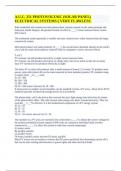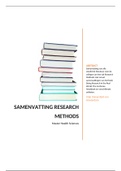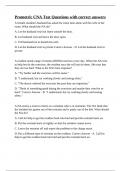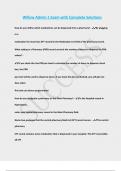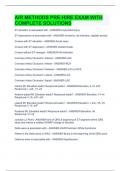Hollenbeck et al. 2012
Critical article. Classical taxonomy was simple: you had production teams (output oriented, focused
on efficiency) and you had decision-making teams (information sharing, innovation). You cannot
assume that each team is exactly the same, there is differentiation. You cannot assume that team
characteristics are always normally distributed: the team placed in the category is not representative
of this category.
They say that when you have a normal distribution in a category (ideal situation) this still means that
only the top of that normal distribution is truly representative of your category. There is only a small
% which do not fall in your category, but the majority of your distribution does not fall within the
category. The top is not truly representative. What happens in a team is unique.
Hollenbeck want to move away from production- and decision-making teams, and create new
dimensions. There are several foundations of why people work together in teams: other members
bring skills you can learn from (skill differentiation).
Teams are not existing for life. Hollenback said that each of these dimensions are independent from
eachother. You can have self-managed teams which have been together for a long period of time, or
self-managed teams that has been together shortly and which is very centralized. Therefore there
will be multiple combinations.
Teams are small groups of interdependent individuals who share responsibility for outcomes. Team-
based structures play an important role in organizations. However, research has developed many
diverse and confusing taxonomies on how to describe or classify teams.
The problem with the classic taxonomy is that it assumed that all teams are equal, while teams are
often dichotomous/not normally distributed. It is difficult to compare teams: you cannot generalize
findings for a particular team for other teams, even when the characteristics are normally
distributed.
,Hollenback looked at the underlying dimensions of team descriptions:
1. Skill differentiation: the degree to which members have specialized knowledge or functional
capabilities that make it more/less difficult to substitute members.
2. Authority differentiation: degree to which decision-making responsibility is vested in
individual members, subgroups of the team or the collective as a whole.
3. Temporal stability: degree to which members have a history working together in the past/ an
expectation of working together in the future.
Marks et al. 2001
Team processes: members interdependent acts that convert inputs to outcomes through verbal, and
behavioral activities directed towards organizing task work to achieve collective goals. This is work
related behavior.
Team work: a team’s interactions with tasks, tools, machines and systems.
The team task is what the team is doing and the team processes is how are they doing it together.
They distinguished that in addition to these task-related processes you also have emergent states: all
collective attitudes, values, feelings etc. people have while working together. Team qualities that
represent member attitudes, values, cognitions and motivations. Typically dynamic and vary as a
function of team context, inputs, processes and outcomes. Emergent states are products of social
team experiences and become inputs to subsequent team processes and outcomes. They are not
themselves directly task related.
The upper model is the traditional model. You had input factors (organizational, team etc.) that led to
tasks processes and that led to some kind of performance outcome. Now, we recognize that team
and individual influences each other. There are interchangeable effects. They lead to tasks processes
and emergent states. That leads to certain outcomes with loops in between: these outcomes can also
influence the processes, and the processes can also influence the inputs.
, In each team, you have action and transition phases. Team members need to set out strategic actions
(what/how) team need to actually do it, get into action. There are differences between these 2
phases, some teams change a lot in between these two phases. Marks does say that these two
phases are an ongoing process: the social processes take so much time, this first needs to be
handled. People first need to get conflicts out of the way before they can think of the transition
phases.
Task 1: agile teams. Constantly revisiting your own strategies to make sure that you perform
optically. Mostly start-up companies. These firms still develop themselves and are in an unstable
position. They need to constantly redefine goals and missions.
Task 2: Military teams, surgery teams, science teams. They can not have short cycles and just ‘try
things out’. They can not revisit their strategy once they already did go into action. The transition
phase is short. The action phase takes a very long time and is very complex.
Task 3:
Task 4: in the beginning, teams are not in transition or action phase. They need to handle conflicts
first before getting into the transition phase. A lot of emergent states and social processes are going
on before you can think about the other stages.
Transition stage: periods of time when teams focus on evaluation and/or planning activities to guide
their accomplishment of a team goal or objective. How to work with each other?
mission analysis, goal specification and strategy formulation and planning
Action stage: periods of time when teams are engaged in acts that contribute directly to goal
accomplishment, such as task work.
monitoring progress towards goals, system monitoring, team monitoring and coordination.
Interpersonal processes: processes that occur in both transition and action phases. They lie the
foundation for effectiveness of other processes. Directly related to different types of outcomes in
either the transition or the action phase.
conflict management, motivation and confidence building and affect management
Ashforth, 1989
He argued that groups have a function in organization. Organizations want people to work in groups:
they can generate new ideas, we can socialize, we can handle complex tasks which we cannot do
alone. The benefits that organizations describe, are not the benefits the people describe. We do
want to belong to teams and others (it is in our nature).
Critical article. Classical taxonomy was simple: you had production teams (output oriented, focused
on efficiency) and you had decision-making teams (information sharing, innovation). You cannot
assume that each team is exactly the same, there is differentiation. You cannot assume that team
characteristics are always normally distributed: the team placed in the category is not representative
of this category.
They say that when you have a normal distribution in a category (ideal situation) this still means that
only the top of that normal distribution is truly representative of your category. There is only a small
% which do not fall in your category, but the majority of your distribution does not fall within the
category. The top is not truly representative. What happens in a team is unique.
Hollenbeck want to move away from production- and decision-making teams, and create new
dimensions. There are several foundations of why people work together in teams: other members
bring skills you can learn from (skill differentiation).
Teams are not existing for life. Hollenback said that each of these dimensions are independent from
eachother. You can have self-managed teams which have been together for a long period of time, or
self-managed teams that has been together shortly and which is very centralized. Therefore there
will be multiple combinations.
Teams are small groups of interdependent individuals who share responsibility for outcomes. Team-
based structures play an important role in organizations. However, research has developed many
diverse and confusing taxonomies on how to describe or classify teams.
The problem with the classic taxonomy is that it assumed that all teams are equal, while teams are
often dichotomous/not normally distributed. It is difficult to compare teams: you cannot generalize
findings for a particular team for other teams, even when the characteristics are normally
distributed.
,Hollenback looked at the underlying dimensions of team descriptions:
1. Skill differentiation: the degree to which members have specialized knowledge or functional
capabilities that make it more/less difficult to substitute members.
2. Authority differentiation: degree to which decision-making responsibility is vested in
individual members, subgroups of the team or the collective as a whole.
3. Temporal stability: degree to which members have a history working together in the past/ an
expectation of working together in the future.
Marks et al. 2001
Team processes: members interdependent acts that convert inputs to outcomes through verbal, and
behavioral activities directed towards organizing task work to achieve collective goals. This is work
related behavior.
Team work: a team’s interactions with tasks, tools, machines and systems.
The team task is what the team is doing and the team processes is how are they doing it together.
They distinguished that in addition to these task-related processes you also have emergent states: all
collective attitudes, values, feelings etc. people have while working together. Team qualities that
represent member attitudes, values, cognitions and motivations. Typically dynamic and vary as a
function of team context, inputs, processes and outcomes. Emergent states are products of social
team experiences and become inputs to subsequent team processes and outcomes. They are not
themselves directly task related.
The upper model is the traditional model. You had input factors (organizational, team etc.) that led to
tasks processes and that led to some kind of performance outcome. Now, we recognize that team
and individual influences each other. There are interchangeable effects. They lead to tasks processes
and emergent states. That leads to certain outcomes with loops in between: these outcomes can also
influence the processes, and the processes can also influence the inputs.
, In each team, you have action and transition phases. Team members need to set out strategic actions
(what/how) team need to actually do it, get into action. There are differences between these 2
phases, some teams change a lot in between these two phases. Marks does say that these two
phases are an ongoing process: the social processes take so much time, this first needs to be
handled. People first need to get conflicts out of the way before they can think of the transition
phases.
Task 1: agile teams. Constantly revisiting your own strategies to make sure that you perform
optically. Mostly start-up companies. These firms still develop themselves and are in an unstable
position. They need to constantly redefine goals and missions.
Task 2: Military teams, surgery teams, science teams. They can not have short cycles and just ‘try
things out’. They can not revisit their strategy once they already did go into action. The transition
phase is short. The action phase takes a very long time and is very complex.
Task 3:
Task 4: in the beginning, teams are not in transition or action phase. They need to handle conflicts
first before getting into the transition phase. A lot of emergent states and social processes are going
on before you can think about the other stages.
Transition stage: periods of time when teams focus on evaluation and/or planning activities to guide
their accomplishment of a team goal or objective. How to work with each other?
mission analysis, goal specification and strategy formulation and planning
Action stage: periods of time when teams are engaged in acts that contribute directly to goal
accomplishment, such as task work.
monitoring progress towards goals, system monitoring, team monitoring and coordination.
Interpersonal processes: processes that occur in both transition and action phases. They lie the
foundation for effectiveness of other processes. Directly related to different types of outcomes in
either the transition or the action phase.
conflict management, motivation and confidence building and affect management
Ashforth, 1989
He argued that groups have a function in organization. Organizations want people to work in groups:
they can generate new ideas, we can socialize, we can handle complex tasks which we cannot do
alone. The benefits that organizations describe, are not the benefits the people describe. We do
want to belong to teams and others (it is in our nature).



